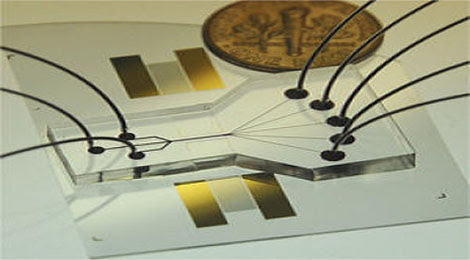The device uses the force generated by light to flop a mechanical switch of light on and off at a very high speed. This development could lead to advances in computation and signal processing using light instead of electrical current with higher performance and lower power consumption. The research results were published today in the online journal Nature Communications.
University of Minnesota researchers have invented a novel microscale mechanical switch of light on a silicon chip.
"This device is similar to electromechanical relays but operates completely with light," said Mo Li, an assistant professor of electrical and computer engineering in the University of Minnesota's College of Science and Engineering.
The new study is based on a previous discovery by Li and collaborators in 2008 where they found that nanoscale light conduits can be used to generate a strong enough optical force with light to mechanically move the optical waveguide (channel of information that carries light). In the new device, the researchers found that this force of light is so strong that the mechanical property of the device can be dominated completely by the optical effect rather than its own mechanical structure. The effect is amplified to control additional colored light signals at a much higher power level.
"This is the first time that this novel optomechanical effect is used to amplify optical signals without converting them into electrical ones," Li said.
Glass optical fibers carry many communication channels using different colors of light assigned to different channels. In optical cables, these different-colored light channels do not interfere with each other. This non-interference characteristic ensures the efficiency of a single optical fiber to transmit more information over very long distances. But this advantage also harbors a disadvantage. When considering computation and signal processing, optical devices could not allow the various channels of information to control each other easily…until now.
The researchers' new device has two optical waveguides, each carrying an optical signal. Placed between the waveguides is an optical resonator in the shape of a microscale donut (like a mini-Hadron collider.) In the optical resonator, light can circulate hundreds of times gaining intensity.
Using this resonance effect, the optical signal in the first waveguide is significantly enhanced in the resonator and generates a very strong optical force on the second waveguide. The second waveguide is released from the supporting material so that it moves in oscillation, like a tuning fork, when the force is applied on it. This mechanical motion of the waveguide alters the transmission of the optical signal. Because the power of the second optical signal can be many times higher than the control signal, the device functions like a mechanical relay to amplify the input signal.
Currently, the new optical relay device operates one million times per second. Researchers expect to improve it to several billion times per second. The mechanical motion of the current device is sufficiently fast to connect radio-frequency devices directly with fiber optics for broadband communication.
Li's team at University of Minnesota includes graduate students Huan Li, Yu Chen and Semere Tadesse and former postdoctoral fellow Jong Noh. Funding support of the project came from the University of Minnesota College of Science and Engineering and the Air Force Office of Scientific Research.
From phys











